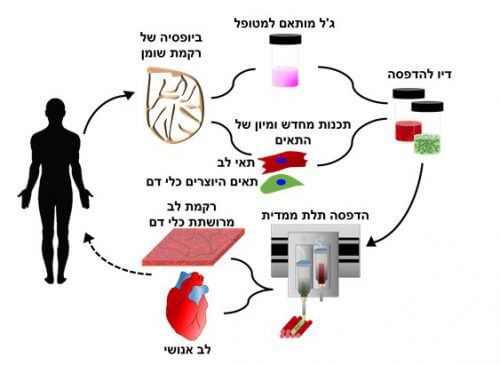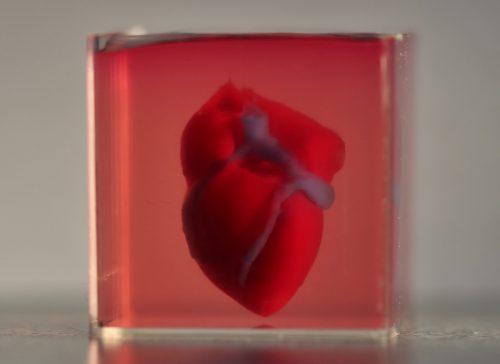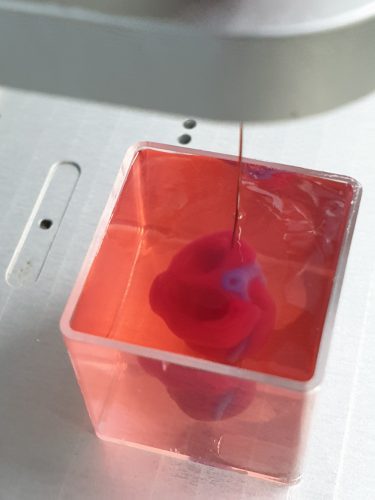Researchers at Tel Aviv University announced progress in the direction of producing a patch for the heart after a stroke, and later also printing an entire heart with a printer * They were able to produce a miniature heart from human fat cells with a XNUMXD printer in about three hours. The research findings were published last night in the journal Advanced Science

In the future there is a chance that we will not need organ transplants from the bodies of donors, if the method for printing a whole heart that was demonstrated yesterday at Tel Aviv University at the same time as the article published in the journal Advanced Science. stew. At least, the researchers hope, it will be possible to use the technology to produce heart tissue to replace scarred cells damaged by a heart attack.
Researchers in Prof. Tal Dvir's laboratory at Tel Aviv University succeeded, for the first time in the world, in solving a very significant challenge in modern medicine: using a 2.5D printer and tissues taken from a patient to print a living heart. The cells from which the heart is built were taken from a person's abdominal fat cells, but the diameter of the heart they have reached so far is about XNUMX centimeters, about the size of a rabbit's heart.
The groundbreaking research was carried out by PhD student Nadav Noor and Dr. Assaf Shapira in Prof. Dvir's laboratory, in the School of Molecular Cell Biology and Biotechnology in the Faculty of Life Sciences, in the Department of Materials Engineering in the Faculty of Engineering, and in the Sagol Center for Regenerative Biotechnology - all at Tel Aviv University.
"Since the technology of XNUMXD printing was invented, researchers all over the world are trying to use it to print, among other things, tissues and organs for transplantation," says Prof. Dvir. "We have developed a new technology, which provides an answer to a significant part of the difficulties that arose along the way."
For the purpose of the study, the researchers used fat tissue taken from a patient, and separated the fat cells from the extracellular collagen material that supports the cells. In an advanced process of genetic engineering, they turned the fat cells into stem cells, and the stem cells created heart muscle cells and cells that form blood vessels. At the same time, they created a kind of 'ink' for printing from the collagenous material. Now they mixed all the ingredients and fed the mixture to the printer, which printed according to computer instructions, according to MRI and CT images of a human heart. The heart printed in this way is composed of very young cells, which are already contracting and showing properties of heart cells. Today, the researchers are working on growing the heart in a special environment (bioreactor), until the cells become mature heart cells that communicate with each other and work with maximum efficiency. The researchers hope that printed hearts of this type will be implanted in animals in the coming year, in order to test their function.
"The method we developed makes it possible to print a heart of any desired size, and since the printed heart is produced from the patient's own tissues, the body will not reject it," Prof. Dvir concludes. "Furthermore, the method actually makes it possible to print any organ required for transplantation, and we believe it opens the door to future technologies, which will completely eliminate the need for organ donations. When a patient needs a transplant, tissue will be taken from his body, from which an appropriate organ will be printed in size and properties, which will be implanted in his body."
In a conversation with journalists, Prof. Dvir explained: "Myocardial cells are not cells that divide, we just want them to contract in a synchronized manner. At the same time, we are working on patches designed to treat heart attacks, but as part of the proof of programming, we have shown that we are also able to print an entire heart."
"It is not yet in the clinic, we are still conducting experiments with the biomaterials in pigs, but in the next steps we will implant a complete patch. We want to transplant the hearts within a year or two in small animals - a rabbit, a rat. As soon as something is traded it is out of my hands. The cost at the moment to do it in the laboratory is not like that in the sky, but when you want to do it in humans you have to do it in much more sterile conditions. The amount of cells is much larger."
In response to a question about the difference between the development of the group at Tel Aviv University and other groups in the world and in Israel dealing in similar fields, Prof. Dvir said: "Companies print the material itself but without cells, others print the patches with cells but without blood vessels. In addition, one of our biggest advantages is that the cells come from the patient himself. Others use off-the-shelf materials, but they are not customized for the patient and this encourages an immune response."
In a conversation with the Hidan site, Dr. Assaf Shapira, who is also a participant in the research, explains the process: "We take adipose tissue from the patient whose heart we want to touch and separate this tissue into its components, cells and extracellular material - mainly collagen. We engineer the cells using genetic engineering, turning them into induced stem cells, and then we can sort them into the types of cells we want, in this case, one population of heart muscle cells, and the other population - cells that form blood vessels."
"The significant development is the combination of the ability to accurately print in XNUMXD heart tissue and even a model of an entire heart when both the tissue and the entire heart contain blood vessels and all the anatomical shape required for function, and in addition, all the materials used for printing are customized."
Not only the cells themselves are personalized, but the shape of the heart. A CT scan of the patient's heart is taken, according to which the blood vessels are engineered, and then it can be glued to the area that has been damaged, for example in a heart attack, of course it is seeded with cardiovascular cells and slowly that patch undergoes fusion With the heart, strengthens that damaged part and restores its activity. Little by little the cells start talking to each other. At Patch, we recently conducted an experiment with pigs and saw an improvement. The technology of dimension printing gave us the possibility to produce in high resolution even according to the patient's own anatomy. "
How long does it take to print a heart?
"The small model takes between 3.5 and 4 hours and, of course, if the heart is bigger, the time is accordingly longer, but the machines are also being perfected from time to time. When we take a fat sample and turn it into induced stem cells, the induced stem cells can multiply and then we multiply them in test tubes. As soon as they are sorted, their ability to divide decreases, but until then they are multiplied in large numbers, many millions. Since the cells have the ability to divide as stem cells, there is no need to remove many cells from the body."
But the heart has many more than two types of cells?
Dr. Shapira: "There are more types of cells, but we are currently showing the ability. We can multiply many more types of cells, but the printer. Our machine is capable of printing four types of cells."
Why do fat cells turn into heart cells?
"The specific adipose tissue we want to use is easy to obtain, a minimally invasive surgery in which we extract fat from the omentum, adipose tissue that shields the intestine like a curtain in the abdominal cavity."


for scientific research

2 תגובות
Pretty!
Why do we always pay the price of our desire to rush forward?
Answer: Because they are too weak to resist and they are unable to speak. But they are able to scream when they are hurt or when they are confined for years in sterile cages in laboratory rooms. Solution: This part is hidden from public view.
Prof. Tal Dvir already said in an interview that many volunteers approached him to perform the experiments, so what's the problem? Will it be more difficult? That the rate of progress will slow down? All of this does not justify relegating the IDF to experiments against their will. We as humanity have no moral justification to do this just because it shortens our way. It's possible that if experiments in the BAH were forbidden we would be many years behind, but it's possible not because other methods would have developed. Either way, we do not have the right to speed up progress at the expense of the weak. A life-saving advance? It is clear, but it is also clear to everyone that even for saving lives, not everything is allowed - to avoid experiments on humans (prisoners, retarded, etc.) even though it is clear that they would hasten the progress.
It seems that an organized crime is being committed here that all of humanity cooperates with only because it is for the benefit of humanity. Everyone secretly knows this is a crime (hence the cover-ups) but everyone turns a blind eye with a common wink and so it continues to be committed. For the animals it is an indescribable suffering, for us - a light hit in the wing. But it must be remembered that general consent to the commission of a crime does not qualify it, especially not so serious a crime.